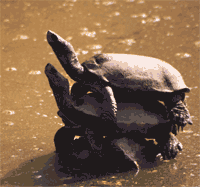 WARNING: It is now illegal to breed terrapins in the UK. This article is for informational purposes only. You must not breed terrapins if you are in the UK. Please see this link for more details.
WARNING: It is now illegal to breed terrapins in the UK. This article is for informational purposes only. You must not breed terrapins if you are in the UK. Please see this link for more details.
The breeding nature of captive terrapins is different from that of a turtles in the wild. In captivity, the maturity for mating is determined by their size and not the age.
On attaining the length of 4 inches (at approximately 1.5 years), the male terrapins get sexually matured while the female terrapins mature at 6 inches (normally at 3 years).
The full grown male and the female terrapins can be detected by observing a few external differences. Normally the males are less bulky and streamlined than the females. The tail, tail-base, cloacal position as well as the shell are also different in the two sexes.
In the beginning of the spring time, terrapins copulate in water. The female terrapins generally lay eggs between April and July. A single female can deposit 4 to 12 eggs for every set of copulation (clutching).
Incubation of terrapin eggs is done in a humid vermiculite at 80° to 85° F without changing the orientation of the eggs. The temperature during the incubation actually determines the sex of a terrapin.
Higher temperature gives rise to females while the hatching of males need lower temperature. Production of steroidogenic hormones during the second trimester is also partially responsible for the sex determination.
Before copulation, the terrapins take some time to accept and convince each other. The male waves/vibrates his claws in front of the female to seduce her. The mating generally takes place at night.
The female terrapin lays eggs at the right season and in favorable climate. For captive terrapins, an arrangement of a deep, box-type container, layered with damp, warm and soft sand, can be made for the deposition of eggs which are then removed carefully for incubation.
Fertilization by the male sperm takes place before the egg-shell forms. The female’s appetite doubles during production of eggs but before laying, they stop eating. Hatching needs about two months of incubation.
The hatchlings, with the egg-tooth located on the snout, emerge out by breaking the leathery egg shell. Though initially they survive on the umbilical sac, later they should be given various staple foods for better growth. Following conditions can increase the possibility of successful mating:
- Providing an artificial shower
- Reducing and then increasing the water temperature
- Changing the intensity of the artificial lighting
- Keeping them separate for a couple of months
- Keeping them out in the sun during summer
- Individual hibernation
- The diet of the terrapins
To find out more about successfully breeding terrapins please see my Turtle Guide Book review.
